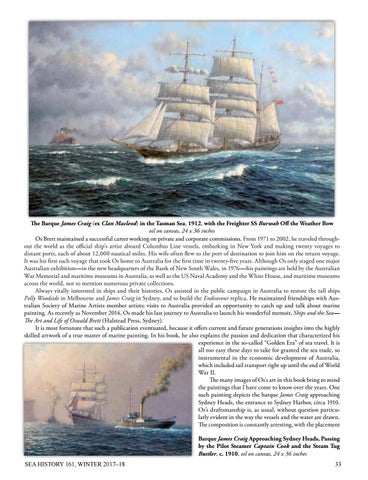The Barque James Craig (ex Clan Macleod) in the Tasman Sea, 1912, with the Freighter SS Burwah Off the Weather Bow oil on canvas, 24 x 36 inches Os Brett maintained a successful career working on private and corporate commissions. From 1971 to 2002, he traveled throughout the world as the official ship’s artist aboard Columbus Line vessels, embarking in New York and making twenty voyages to distant ports, each of about 12,000 nautical miles. His wife often flew to the port of destination to join him on the return voyage. It was his first such voyage that took Os home to Australia for the first time in twenty-five years. Although Os only staged one major Australian exhibition—in the new headquarters of the Bank of New South Wales, in 1976—his paintings are held by the Australian War Memorial and maritime museums in Australia, as well as the US Naval Academy and the White House, and maritime museums across the world, not to mention numerous private collections. Always vitally interested in ships and their histories, Os assisted in the public campaign in Australia to restore the tall ships Polly Woodside in Melbourne and James Craig in Sydney, and to build the Endeavour replica. He maintained friendships with Australian Society of Marine Artists member artists; visits to Australia provided an opportunity to catch up and talk about marine painting. As recently as November 2014, Os made his last journey to Australia to launch his wonderful memoir, Ships and the Sea— The Art and Life of Oswald Brett (Halstead Press, Sydney). It is most fortunate that such a publication eventuated, because it offers current and future generations insights into the highly skilled artwork of a true master of marine painting. In his book, he also explains the passion and dedication that characterized his experience in the so-called “Golden Era” of sea travel. It is all too easy these days to take for granted the sea trade, so instrumental in the economic development of Australia, which included sail transport right up until the end of World War II. The many images of Os’s art in this book bring to mind the paintings that I have come to know over the years. One such painting depicts the barque James Craig approaching Sydney Heads, the entrance to Sydney Harbor, circa 1910. Os’s draftsmanship is, as usual, without question particularly evident in the way the vessels and the water are drawn. The composition is constantly arresting, with the placement Barque James Craig Approaching Sydney Heads, Passing by the Pilot Steamer Captain Cook and the Steam Tug Bustler, c. 1910, oil on canvas, 24 x 36 inches SEA HISTORY 161, WINTER 2017–18 33
Issuu converts static files into: digital portfolios, online yearbooks, online catalogs, digital photo albums and more. Sign up and create your flipbook.
